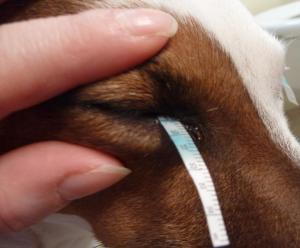Keratoconjunctivitis sicca in Dogs
- posted: Feb. 19, 2017
 When a Dry Eye in the House is Not a Good Thing
When a Dry Eye in the House is Not a Good Thing
Keratoconjuctivitis sicca, more commonly known as KCS or “dry eye” is a condition that can affect dogs due to lack of normal tear production. KCS has several different causes including congenital defect of the tear glands, infection of the tear glands, or damage to the glands by certain drugs. It may also be secondary to other conditions like diabetes. These conditions cause inflammation and shrinkage of the tear gland reducing tear production and causing the eye to produce large amounts of mucus in an effort to protect the cornea. Lack of a proper tear film may even lead to ulcers or dark pigment forming on the surface of the cornea. These changes can lead to vision loss.
Dogs with KCS will have thick mucus coating their eyes, may squint or blink frequently and the eyes may look red. Commonly affected breeds include both Cavalier King Charles and Cocker Spaniels, English Bulldogs, Pugs, Shih Tzus, Lhasa Apsos and Westies.
Dogs are diagnosed by a simple test called a Schirmer tear test which is a small strip of paper containing dye and a scale on the strip. The strip is hooked over the edge of the lower eyelid for one minute. Tear production causes the dye to travel down the strip and can then be measured. Low or absent tear production in one or both eyes would confirm KCS.
Dogs with KCS can be treated with topical eye drops or ointments similar to those used in humans with dry eye. Cyclosporine is the most common drug used but other topical drugs are sometimes employed and artificial tear drops to keep the eyes lubricated are also helpful. Dogs may also have secondary bacterial infection due to lack of a normal tear film so treating with antibiotic drops may also be necessary. Lifelong treatment should be expected, and, your dog should periodically have her tear production checked.
If your dog is experiencing any signs of KCS especially if he or she is an at-risk breed, have him or her checked. Early detection and treatment can often reduce the risk of permanent damage to the eye and decrease the discomfort of dry eye.
This blog brought to you by the Patton Veterinary Hospital serving Red Lion, York, and the surrounding communities.
Source: Veterinary Team Brief January/February 2017 Volume 5 Number 1 pp. 33-36
Location
Patton Veterinary Hospital
425 E Broadway
Red Lion, PA 17356
